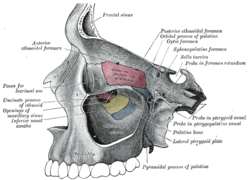Pterygopalatine fossa
| Pterygopalatine fossa | |
|---|---|
 Left maxillary sinus opened from the exterior. | |
 Human skull with entrance to pterygopalatine fossa marked in red | |
| Details | |
| Identifiers | |
| Latin | fossa pterygopalatina |
| MeSH | D056739 |
| TA98 | A02.1.00.025 |
| TA2 | 429 |
| FMA | 75309 |
| Anatomical terms of bone | |
In human anatomy, the pterygopalatine fossa (sphenopalatine fossa) is a
pterygoid process and the maxillary tuberosity close to the apex of the orbit.[1] It is the indented area medial to the pterygomaxillary fissure leading into the sphenopalatine foramen. It communicates with the nasal and oral cavities, infratemporal fossa, orbit, pharynx, and middle cranial fossa through eight foramina.[2]
Structure
Boundaries
It has the following boundaries:
- anterior: superomedial part of the infratemporal surface of maxilla
- posterior: root of the greater wing of sphenoid bone
- medial: sphenoidal processes
- lateral: pterygomaxillary fissure
- inferior: part of the floor is formed by the pyramidal processof the palatine bone.
Passages
The following passages connect the fossa with other parts of the skull:[3]
| Direction | Passage | Connection |
|---|---|---|
| Posteriorly | foramen rotundum | middle cranial fossa |
| pterygoid canal (Vidian) | middle cranial fossa, foramen lacerum | |
| palatovaginal canal (pharyngeal) | nasopharynx
| |
| Anteriorly | inferior orbital fissure | orbit |
| Medially | sphenopalatine foramen | nasal cavity |
| Laterally | pterygomaxillary fissure | infratemporal fossa |
| Inferiorly | greater palatine canal (pterygopalatine) | oral cavity ,
|
Functions
The pterygopalatine fossa contains
- the pterygopalatine ganglion suspended by nerve roots from the maxillary nerve
- the terminal third of the maxillary artery
- the maxillary nerve (CN V2, the second division of the trigeminal nerve), with which is the parasympathetic) and the deep petrosal nerve (postganglionic sympathetic). To obtain block anesthesia of the entire second division of the trigeminal nerve, an intraoral injection can be administered into this area.
See also
Additional images
References
- ^ Illustrated Anatomy of the Head and Neck, Fehrenbach and Herring, Elsevier, 2012, page 69
- PMID 106641.
- ISBN 9780702029714.




